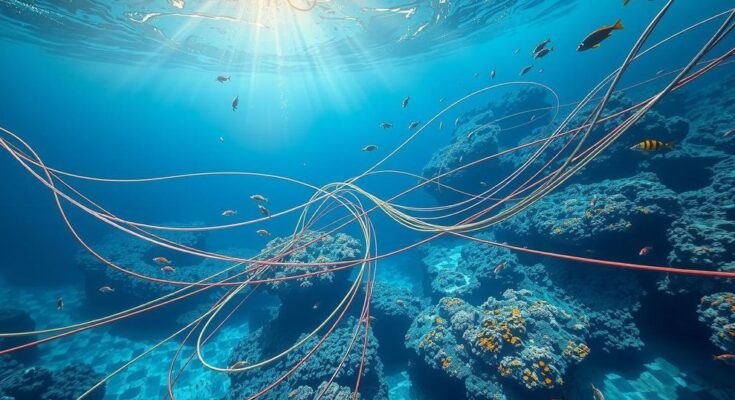Meta has announced the construction of the Waterworth project, a 50,000-kilometer submarine cable aimed at improving global connectivity. Besides telecommunications, advanced cables like SMART, used for environmental monitoring, can enhance disaster preparedness and climate change understanding. However, challenges such as outdated regulations and concerns over financial feasibility must be addressed for broader adoption.
Submarine cables are vital for global connectivity, and their potential extends beyond telecommunications. Recently, Meta proposed to construct the world’s longest communication cable, the Waterworth project, spanning 50,000 kilometers to connect five continents, enhancing technological development in diverse nations such as the United States, India, and Brazil. Globally, about 1.4 million kilometers of submarine cables facilitate data transmission at remarkable speeds of up to 300 terabits per second.
Beyond improving connectivity, the evolution of submarine cables into multipurpose systems, such as SMART (Scientific Monitoring and Reliable Telecommunications) cables, is noteworthy. These cables, designed for environmental monitoring in collaboration with international organizations, incorporate sensors that track critical data like seismic activity and ocean temperatures, aiding in disaster preparedness as well as climate change research.
Currently, countries including France and Portugal are investing in these advanced cables. However, the uptake of sensing cables is sluggish due to outdated regulations, unclear business models regarding financial viability, and potential security risks associated with embedding sensors in these cables that may be perceived as surveillance tools by certain governments.
Despite these challenges, the benefits of enhanced ocean data collection via SMART cables are significant. Improved knowledge on ocean conditions can assist various industries, optimize operations, and inform strategies to combat climate change. Updating regulations could facilitate the integration of sensing technologies into ambitious projects like Meta’s Waterworth initiative.
Portugal exemplifies a proactive approach by investing in SMART cables to advance climate data collection, serving as a potential model for other nations. While embedding sensors may not resolve the climate crisis, it represents a necessary step toward comprehending our oceanic environments better and addressing the pressing challenges of climate change effectively.
In conclusion, submarine cables play an essential role in maintaining global connectivity while also presenting opportunities for environmental monitoring through newer technologies like SMART cables. Addressing regulatory, financial, and security concerns will be pivotal for the widespread adoption of these innovative tools. By leveraging ocean data more effectively, countries can better prepare for climate-related challenges and contribute to global efforts in addressing environmental changes.
Original Source: theconversation.com




